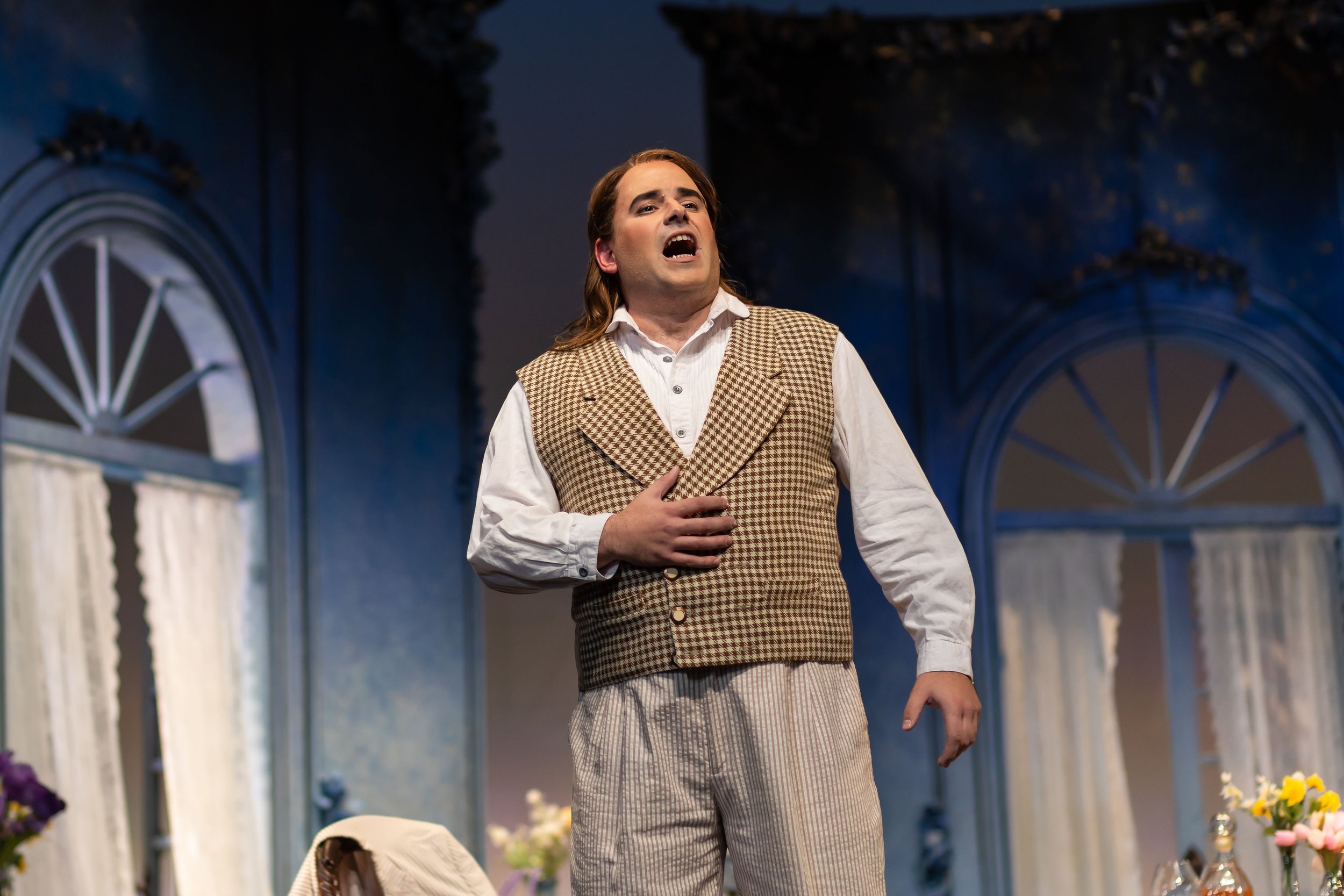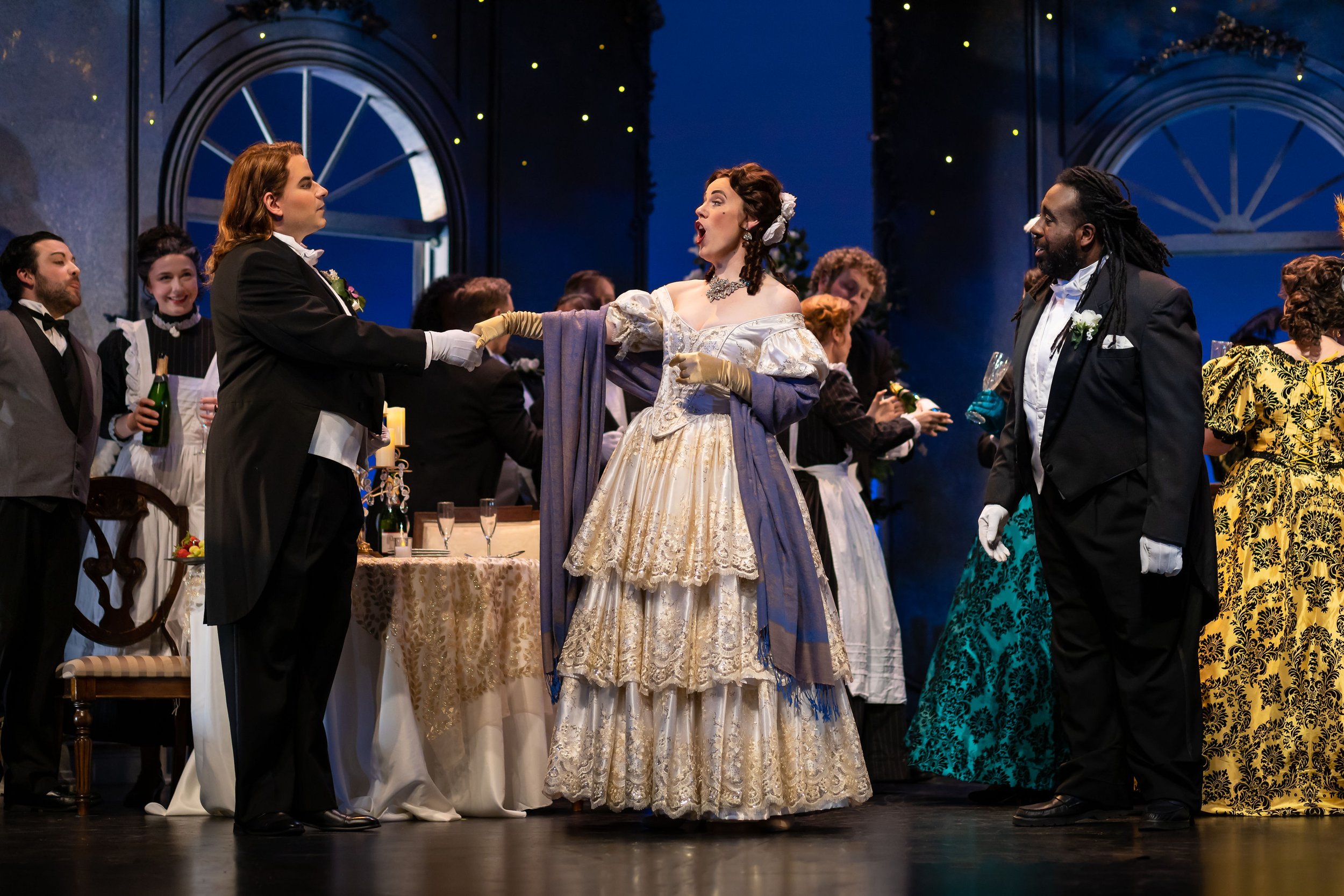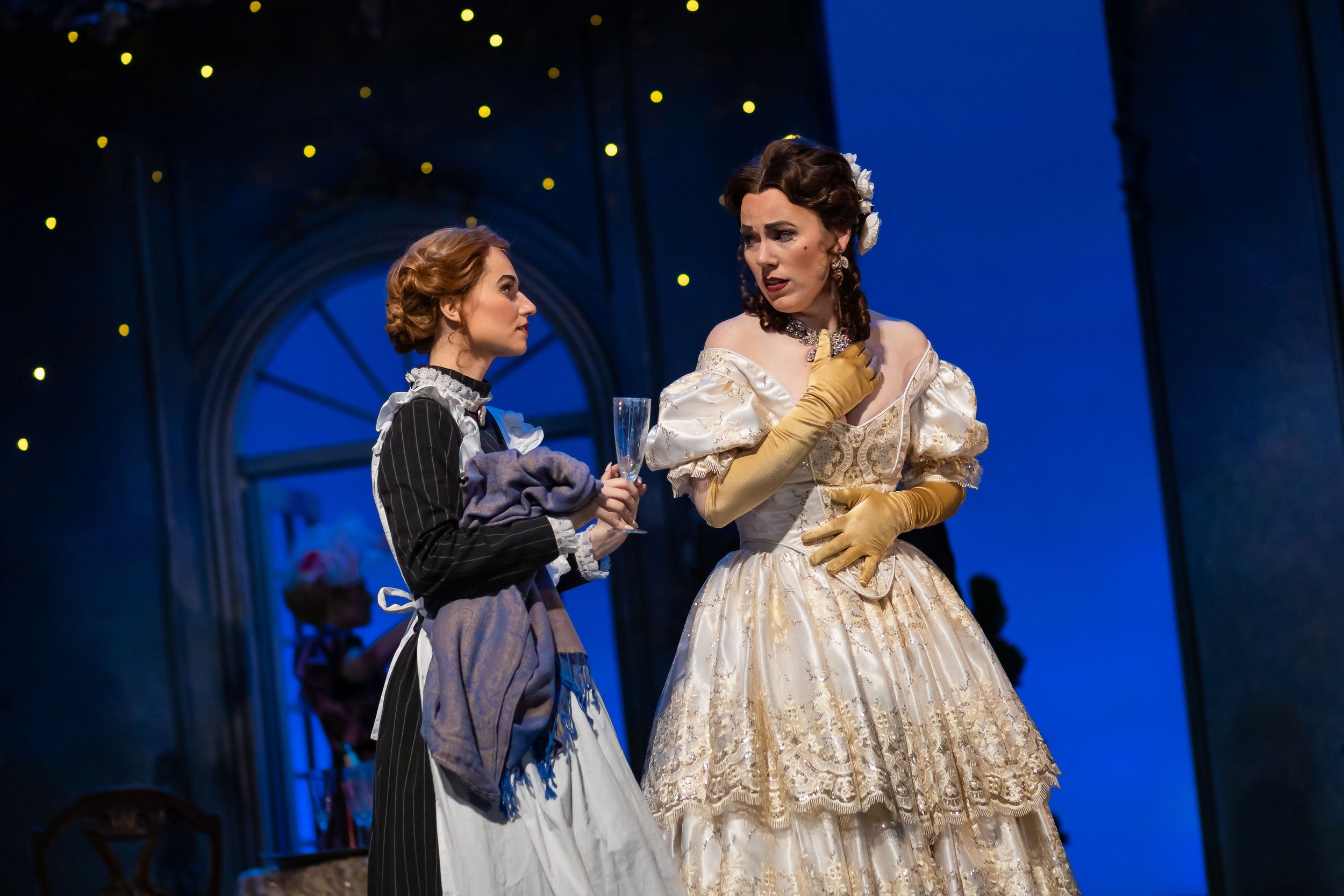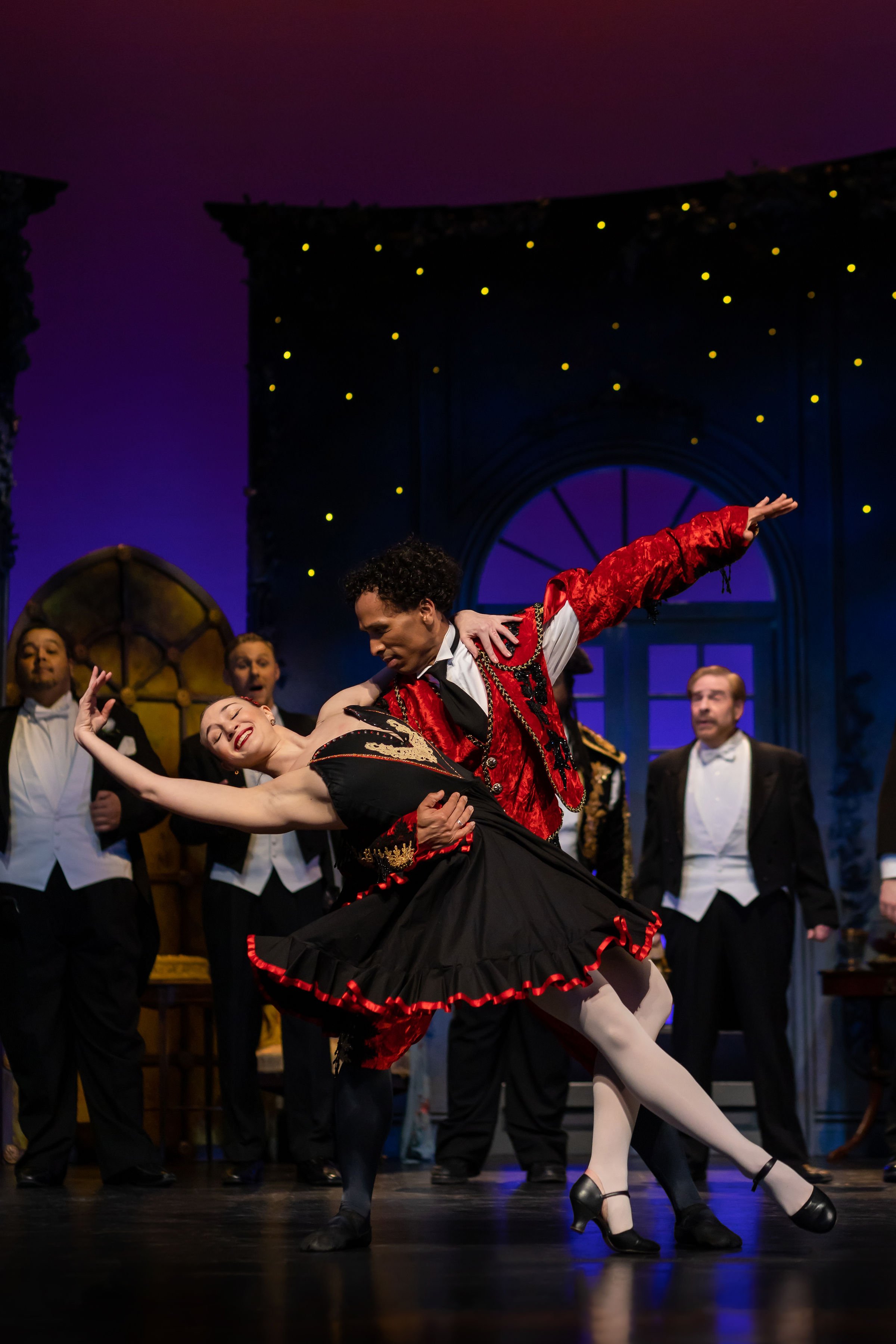You might think because I saw another production of La Traviata just two weeks ago that I might have little to say. If so, you don’t know Violetta! La Traviata (1853) by composer Giuseppe Verdi and librettist Francesco Maria Piave was Opera Baltimore’s second fully staged production, and like last year’s The Barber of Seville, the opera played to a packed house in both performances --- and deservedly so. Look, I gave up March Madness to attend Friday night’s performance, and all through the performance I kept thinking that this experience was so much richer than anything on TV. Part of my response was that it was a live performance of singing, music, and storytelling being enjoyed as part of a community, part of it was the greatness and sheer pleasure of Verdi’s music, and part of it was the life breathed into La Traviata, with love, by Opera Baltimore.
Soprano Lindsay Ohse plays Violetta in Opera Baltimore’s performance of La Traviata. Photo by Kiirstn Pagan; courtesy of Opera Baltimore.
In La Traviata (translated as “a fallen woman”), Violetta is a highly sought after French courtesan who is committed to living for pleasure and frequents lavish salon parties with her upper-class gentlemen benefactors; she has contracted tuberculosis and is faltering. She is wooed and falls in love with a young gentleman, Alfredo. Violetta experiences true love for the first time, and they live together briefly, until Giorgio, Alfredo’s father, visits her to demand, then plead with her to give Alfredo up before she sullies the family name and reputation, which would ruin Alfredo’s sister’s chances of marrying into a good family. Violetta, whose sickness is worsening, gives in, proving her virtue and honor, showing her to be a person of courage and resolve. She slips away and returns to the Baron, her previous sponsor, as the only way to make Alfredo leave her side. Alfredo, angry at this apparent rejection of his sincere devotion, denounces her in an ugly confrontation in front of a shocked salon party crowd and goes abroad. In the finale, Alfredo has been told of Violetta’s sacrifice by Giorgio, who has grown to deeply respect her, and Alfredo returns to renew his vows to Violetta, finding her on her death bed. Now, that’s opera!
left photo: Matthew Vickers as Alfredo. right photo: Benjamin Taylor as Giorgio. Photo by Kiirstn Pagan; courtesy of Opera Baltimore.
The great opera composers were not only imbued with extraordinary musical and compositional talent, but they were also gifted with an acute ability to recognize the complexities of human personalities; their characters are typically a mix of admirable and not so admirable qualities. In most cases, that ability matured over time as did their musical talents. One report I read on composer Verdi said that in 1844, a close friend recommended a work to Verdi as a possible source for an opera. Verdi is quoted as responding, “I know the subject you suggest. The heroine is a character I don’t like. I don’t like prostitutes on the stage…“.
Matthew Vickers as Alfredo and Lindsay Ohse as Violetta backed by a cast emsemble. Photo by Kiirstn Pagan; courtesy of Opera Baltimore.
Yet, in 1852 he began work on an opera about a French courtesan, a high-level prostitute, determined to show her good heart and honorable soul…on stage. Why the change in attitude you might ask; maybe Verdi just knew a good subject for an opera when he saw it, but there is more to the story to consider. The source further notes that Verdi found the story for La Traviata in a play he attended titled La Dame aux camélias by Alexandre Dumas, fils, a play that Verdi attended with the famous soprano Giuseppina Strepponi, a sophisticated, cultivated woman who gave birth to three children out of wedlock and while details are murky, not all from the same father. She later became Verdi’s wife, remaining so until she died. Verdi wanted to title the opera Amore e Morte (Love and Death), a subject Verdi knew well from personal experience, but the sensors would not allow it. He also strongly wanted the opera to be set in his own time period, the middle of the 18th century, but opera companies insisted it be moved to the year 1700, perhaps fearing it struck a little too close to home? I think there are connections between all these events, to each other and to viewing audiences that have been seminal in making La Traviata among the most popular operas in the world for 170 years.
La Traviata has three acts that move from the lovers meeting, their time together and breakup, and the death bed. Stage Director Kaley Karis Smith did an excellent job telling the story with a compelling flow in those settings. Her choices added accents to the story, such as an opening scene during the overture that made the point that Violetta was passed between men and such as adding photo-taking, where the expression on Violetta’s face changed dramatically between waiting for the photo to be taken and when the picture is snapped, a hint her life might not be as gay as she professed. I did find it a little concerting that often the singers were singing to the audience and not each other. The sets by Scenic Designer Jefferson Ridenour were attractive and evocative of Verdi’s era, and settings for each act were designed to aid the storytelling. The costumes by Costume Designer Glen Breed were fabulous. Effective lighting changes were employed throughout by Lighting Designer Tláloc López-Watermann.
The Opera Delaware Orchestra under the direction of Conductor Domenico Boyagian played Verdi’s music capably and generally in a satisfying manner (Opera Delaware is a co-producer of the opera). Keep in mind, I’m responding from a single hearing with other parts of the performance competing for my attention, but there were a few times when it left me wanting. I personally found it somewhat lackluster in the first half of the evening, perhaps thin in a few spots in instrument selection, and at one point Alfredo and the orchestra seemed out of sync. The orchestra did have some highlights, such as the crescendo that takes place in the confrontation scene and most of the softer, gentle playing. I was not underwhelmed by the playing but I was expecting to be overwhelmed, and I was just whelmed. I certainly was able to enjoy the beautiful Verdi music that was being played in support and enrichment of the drama.
left photo: Matthew Vickers as Alfredo, Lindsay Ohse as Violetta, and Daniel Sampson as Gaston. right photo: Rachel DiBlasio as Annina and Lindsay Ohse as Violetta. Photo by Kiirstn Pagan; courtesy of Opera Baltimore.
La Traviata is a personal drama; attention is focused almost exclusively on Violetta, Alfredo, and Giorgio, but it is Violetta’s opera. Soprano Lindsay Ohse proved to be an excellent one; her “sempre libra” was simply thrilling. Her trills and coloratura flourishes were good, but it was the beauty of her singing and the emotional palette displayed that were outstanding. She also excelled at acting, a believable, endearing Violetta from beginning to end. Tenor Matthew Vickers who played Alfredo sings well with a burnished tenor voice, and he gave an enjoyable performance, especially singing. I have seen and enjoyed Mr. Vickers’ performances several times. I am almost always impressed with his vocals and almost always wishing his acting was less stiff and formulaic, which I thought it was for much of La Traviata; to his credit, his acting was much stronger from the confrontational scene until the end. Baritone Benjamin Taylor was good as Giorgio, but it was how shockingly good his velvet baritone voice was and how almost effortless his singing was that caught me off guard. His vocals were a highlight. I had a hard time accepting him as Giorgio because the youthful virility in his voice seemed to belong in a romantic lead role. He is certainly a singer not to be missed; he will of course appear when the production moves now to Opera Delaware, and he appears again in late April in Opera Philadelphia’s new production of La Boheme (I have tickets).
left photo: Melanie Ashkar as Flora encircled by dancers/chorus members. right photo: Lead dancers in the ballet, Antonio Rosario and Taylor Ciampi. Photo by Kiirstn Pagan; courtesy of Opera Baltimore.
The performance was further embellished by the overall excellent quality of the supporting cast that included: mezzo-soprano Melanie Ashkar as Violetta’s friend, Flora; tenor Daniel Sampson as Gastone, Alfredo’s friend; baritone Ben Lowe as Barone Douphol, Violetta’s sponsor; mezzo-soprano Rachel DiBlasio as Annina, Violetta’s maid; baritone Jeffrey Gates as Marchese d’Oigny; and bass Mark Hightower as Dottore Grenvil, Violetta’s physician. A strong highlight for me was the chorus which made me sit up and take notice with their impressive, enthusiastic singing throughout the performance; kudos to Chorus Master Aurelien Eulert. The brief ballet in the second half of the second act was a delight, especially the dancing of the two lead dancers, Antonio Rosario (choreographer) and Taylor Ciampi, who gave us a charming pas de deux..
Opera Baltimore’s performance of La Traviata was attractive, polished, and highly entertaining. If you have been to a few of their performances, you know it becomes addictive.
The Fan Experience: La Traviata was performed in Stephens Hall at Towson University on March 24 and 26. The opera was sung in Italian with English surtitles. The opera was about 3 hours including two 15-minute intermissions placed between the acts. My thanks to the folks who set up and staffed the snack and drink stands on the lower level before and during the intermissions; much appreciated. This production was developed in cooperation with Opera Delaware and now moves to the Copeland Hall at the Grand in Wilmington for March 31 and April 2 performances; tickets available at this link.
Opera Baltimore was known as Baltimore Concert Opera until last year and current plans are to continue to offer a mix of concert performances in the Engineers Club and fully staged performances in Stephens Hall. The operas to be performed in the 2023-2024 season will be announced on June 6; both venues are modest in size; so get your tickets early. Opera Baltimore is the only company performing high quality, professional fully staged operas in Baltimore and seems to be growing. The strong ticket sales are encouraging but ticket sales cover less than 20% of the cost of a production; the remainder must be made up from contributors within the community. As always, the community will decide the fate of opera in Baltimore.
Dr. Aaron Ziegel, Associate Professor of Music History and Culture at Towson University provides the pre-opera talks an hour before performances. He also oversees OB’s “Opera Insights” series, four lectures on each upcoming opera, providing a deep dive into the opera itself and insights into the elements of opera and opera history during the period in which the opera was composed. The lectures begin as Zoom calls but are later placed online. They are archived and available for viewing to all, not just ticket holders as in the past, as are the Zoom call presentations.
If you are interested in La Traviata, I especially recommend lecture #1 where Dr. Ziegel discusses the woman who was the inspiration for Dumas’ novel and play and Verdi’s opera, courtesan Marie Duplessis. Learning of her history of sexual abuse at the hands of many men, including her father, made me wonder what Violetta’s history might have been if she were a real person and how her history led her to become a courtesan. We don’t really know Violetta.








